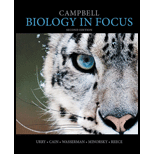
Campbell Biology in Focus (2nd Edition)
2nd Edition
ISBN: 9780321962751
Author: Lisa A. Urry, Michael L. Cain, Steven A. Wasserman, Peter V. Minorsky, Jane B. Reece
Publisher: PEARSON
expand_more
expand_more
format_list_bulleted
Concept explainers
Question
Chapter 4.5, Problem 2CC
Summary Introduction
To explain:
Do plant cells have mitochondria?
Introduction:
Mitochondria are found in animals, plants,
Expert Solution & Answer
Want to see the full answer?
Check out a sample textbook solution
Students have asked these similar questions
Do yeast cells have mitochondria?
Using the concepts of endo- and exo-cytosis explain the origin of the mitochondria. Include a drawing
Explain the difference between mitochondria and chloroplast. Which types of cells have which organelles? Which process are each organelle associated with?
Carbon dioxide + water + energy --> sugar(glucose) + oxygen
sugar(glucose) + oxygen --> carbon dioxide + water + energy
Chapter 4 Solutions
Campbell Biology in Focus (2nd Edition)
Ch. 4.1 - Prob. 1CCCh. 4.1 - Prob. 2CCCh. 4.2 - Briefly describe the structure and function of the...Ch. 4.2 - Prob. 2CCCh. 4.3 - What role do ribosomes play in carrying out...Ch. 4.3 - Describe the molecular composition of nucleoli,...Ch. 4.3 - WHAT IF? As a cell begins the process of dividing,...Ch. 4.4 - Describe the structural and functional...Ch. 4.4 - Describe how transport vesicles integrate the...Ch. 4.4 - WHAT IF? Imagine a protein that functions in the...
Ch. 4.5 - Describe two characteristics shared by...Ch. 4.5 - Prob. 2CCCh. 4.5 - Prob. 3CCCh. 4.6 - Prob. 1CCCh. 4.6 - WHAT IF? Males afflicted with Kartageners syndrome...Ch. 4.7 - In what way are the cells of plants and animals...Ch. 4.7 - Prob. 2CCCh. 4.7 - MAKE CONNECTIONS The polypeptide chain that makes...Ch. 4 - Which structure is not part of the endomembrane...Ch. 4 - Which structure is common to plant and animal...Ch. 4 - Which of the following is present in a prokaryotic...Ch. 4 - Prob. 4TYUCh. 4 - Cyanide binds to at least one molecule involved in...Ch. 4 - What is the most likely pathway taken by a newly...Ch. 4 - Which cell would be best for studying lysosomes?...Ch. 4 - DRAW IT From memory, draw two eukaryotic cells....Ch. 4 - SCIENTIFIC INQUIRY In studying micrographs of an...Ch. 4 - FOCUS ON EVOLUTION Compare different aspects of...Ch. 4 - FOCUS ON ORGANIZATION Considering some of the...Ch. 4 - Prob. 12TYU
Knowledge Booster
Learn more about
Need a deep-dive on the concept behind this application? Look no further. Learn more about this topic, biology and related others by exploring similar questions and additional content below.Similar questions
- Explain the mitochondria and its major functions along with diagram?arrow_forwardIn the image below of a region of the mitochondria, which region would have the highest concentration of hydrogen ions? Choose one from the following: (a) A (b) Barrow_forwardMitochondria and chloroplast have their own DNA and replicate separately from the nucleus and they can synthesize ATP. Can they survive outside of the cell? Explain. Gracias!arrow_forward
- Although both organelles originated as free-living prokaryotes, mitochondria are significantly smaller than chloroplasts. Suggest a reason for this discrepancy.arrow_forwardWhat is mitochondria and give its suitable examples?arrow_forwardThere is a toxic metal that can puncture the outer membrane of the mitochondria which creates a gap on the outer membrane but leaving the inner surface membrane intact. The researchers observed that the poisoned cell died within an hour. Explain what would happen to the cell if there is a gap in the outer membrane.arrow_forward
- What is the special characteristics of mitochondria that makes it different from other organelles.why it is called power house of the cell?arrow_forwardWhat is the special characteristic of mitochondria that makes it different from other organelles.Why is it called power house of the cell?arrow_forwardIdentify two characteristics that make mitochondria different from other organelles .arrow_forward
arrow_back_ios
SEE MORE QUESTIONS
arrow_forward_ios
Recommended textbooks for you
 Human Biology (MindTap Course List)BiologyISBN:9781305112100Author:Cecie Starr, Beverly McMillanPublisher:Cengage Learning
Human Biology (MindTap Course List)BiologyISBN:9781305112100Author:Cecie Starr, Beverly McMillanPublisher:Cengage Learning

Human Biology (MindTap Course List)
Biology
ISBN:9781305112100
Author:Cecie Starr, Beverly McMillan
Publisher:Cengage Learning